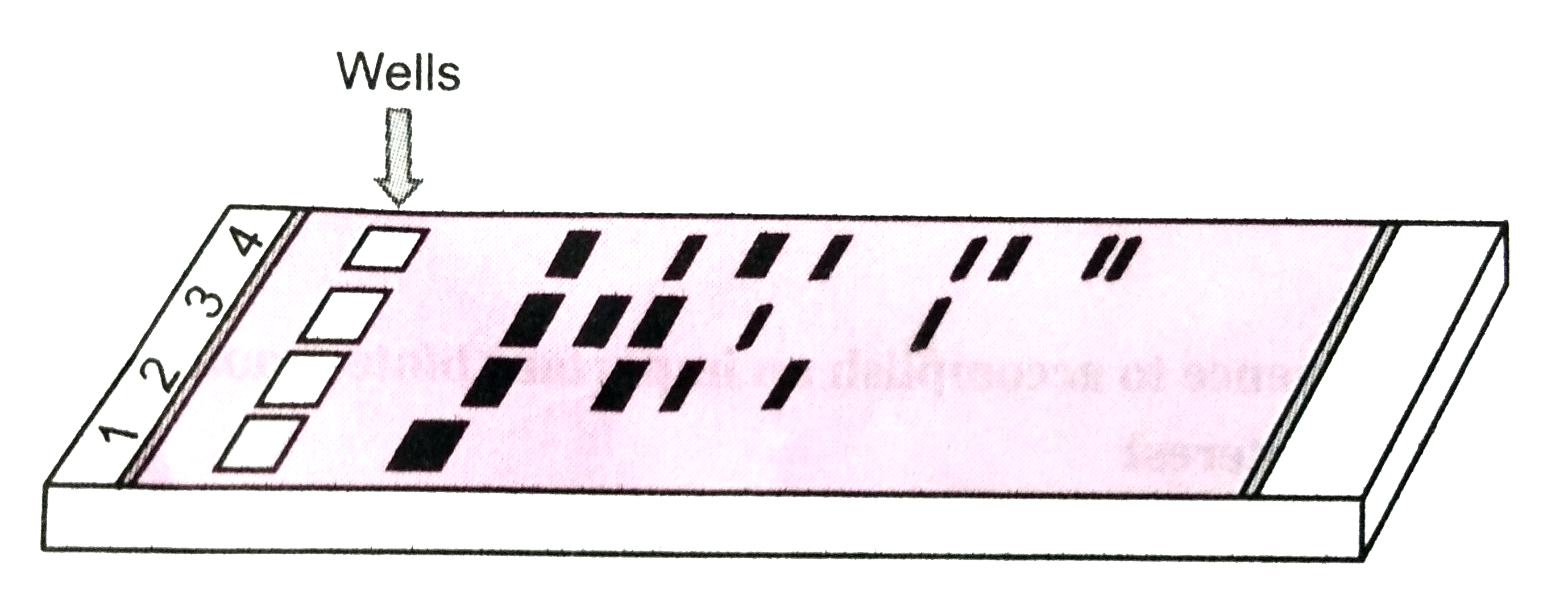Why do DNA fragments move towards the anode during gel electrophoresis ?
Step-by-Step Solution:
1. Understanding Gel Electrophoresis:
- Gel electrophoresis is a technique used to separate DNA fragments based on their size. It involves the use of a semi-solid medium, typically agarose gel, which allows the movement of DNA fragments when an electric current is applied.
2. Electric Current and Charge Movement:
- In electrophoresis, charged particles move in response to an electric field. Charged particles will move towards the electrode with the opposite charge. This means that negatively charged particles will move towards the positive electrode (anode), while positively charged particles will move towards the negative electrode (cathode).
3. Charge of DNA:
- DNA is negatively charged due to its structural components. Each DNA nucleotide contains a phosphate group, which has a negative charge. The negative charge is primarily due to the oxygen atoms in the phosphate backbone of the DNA.
4. Movement of DNA towards Anode:
- Since DNA is negatively charged, when an electric current is applied during gel electrophoresis, the DNA fragments will migrate towards the anode, which is the positive electrode. This movement occurs because opposites attract; the negatively charged DNA is drawn towards the positively charged anode.
5. Conclusion:
- Therefore, DNA fragments move towards the anode during gel electrophoresis because they are negatively charged, and they are attracted to the positive electrode.
---
- Gel electrophoresis is a technique used to separate DNA fragments based on their size. It involves the use of a semi-solid medium, typically agarose gel, which allows the movement of DNA fragments when an electric current is applied.
- In electrophoresis, charged particles move in response to an electric field. Charged particles will move towards the electrode with the opposite charge. This means that negatively charged particles will move towards the positive electrode (anode), while positively charged particles will move towards the negative electrode (cathode).
- DNA is negatively charged due to its structural components. Each DNA nucleotide contains a phosphate group, which has a negative charge. The negative charge is primarily due to the oxygen atoms in the phosphate backbone of the DNA.
- Since DNA is negatively charged, when an electric current is applied during gel electrophoresis, the DNA fragments will migrate towards the anode, which is the positive electrode. This movement occurs because opposites attract; the negatively charged DNA is drawn towards the positively charged anode.
- Therefore, DNA fragments move towards the anode during gel electrophoresis because they are negatively charged, and they are attracted to the positive electrode.
Similar Questions
a) How do DNA fragments migrate and resolve in a Gel electrophoresis?
b) How lane one is different from lane 2,3 and 4 in the GEL electrophoresis set up?
c) How pure DNA fragments are made observable in the visible light?
 View Solution
View Solutiona) How do DNA fragments migrate and resolve in a Gel electrophoresis?
b) How lane one is different from lane 2,3 and 4 in the GEL electrophoresis set up?
c) How pure DNA fragments are made observable in the visible light?
 View Solution
View Solution
Knowledge Check
- Question 1 - Select One
What is the criterion for DNA fragments movement on agarose gel during gel electrophoresis ?
AThe smaller than fragment size, the farther it movesBPositively charged fragments move to farther endCNegatively charged fragments do not moveDThe larger the fragment size, the farther it moves - Question 2 - Select One
What is the criterion for DNA fragments movement on agarose gel during gel electrophoresis ?
AThe larger the fragment size, the farther it movesBThe smaller the fragment size, the farther it movesCPositively charged fragments move to farther endDNegatively charged fragments do not move - Question 3 - Select One
What is the criterion for DNA fragments movement on agarose gel during gel electrophoresis ?
AThe smaller the fragment size, the farther it movesBPositively charged fragments move of farther endCNegatively charged fragments do not moveDThe larger the fragments size, the farther it moves
What is the criterion for DNA fragments movement on agarose gel during gel electrophoresis ?
View SolutionWhat is the criterion for DNA fragments movement on agarose gel during get electrophoresis
View SolutionWhat is the criterion for DNA fragment movement on agarose gel during gel electrophoesis
View SolutionWhat is the following is correct for the movement of DNA fragments on agarose gel during gel electrophoresis ?
View SolutionSeparation and isolation of DNA fragments can be done by a technique called gel electrophoresis. This technique was developed by :
View Solution

